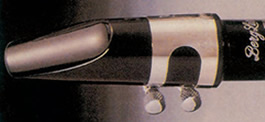When selecting a mouthpiece, there are a number of factors to consider:

1 Tip Opening
The tip opening is the distance between the tip of the reed and the tip of the mouthpiece, measured in thousands of an inch. Generally speaking, the wider the tip opening, the softer the reed that may be used. For most beginners a narrower tip opening will result in a clearer tone and more consistent intonation.
The tip openings available are shown in the green section of the table below, with the most popular ones shown in the red typeface.
|
Mouthpiece Type
|
Tip Opening
|
||||||||||||
|
Instrument
|
Black Ebonite
|
Stainless |
Gold Series Grained
Ebonite |
Gold Series
Bronze |
Close
|
Medium
Close |
Medium
|
Medium
Open |
Open
|
||||
| Bb Soprano Sax |
|
|
|
|
40
|
45
|
50
|
55
|
60
|
65
|
70
|
75
|
80 and more
|
| Eb Alto Sax |
|
|
|
|
70
|
75
|
80
|
85
|
90
|
95
|
100
|
105
|
110
and more
|
| Bb Tenor Sax |
|
|
|
|
90
|
95
|
100
|
105
|
110
|
115
|
120
|
125
|
130
and more
|
| Eb Baritone Sax |
|
|
|
|
90
|
95
|
100
|
105
|
110
|
115
|
120
|
125
|
130
and more
|
2 Tone Chamber
The degree of edge or brightness the player obtains is dictated by the size of the tone chamber. Referring to the diagram above, the more 'baffle' that is built into the tone chamber, the more edge the tone will have. A '0' tone chamber will have the most edge and a '3' will have a more mellow tone.
Tone Chambers: '0' - BRILLIANT, '1' - BRIGHT, '2' - ROUND, '3' - MELLOW.
3 Length of facing
The term 'SMS' or 'M' indicates the choice of facing. The SMS, or French facing is usually shorter with a steeper curve. The 'M' or American facing is slightly longer with a flatter type curve. These facing term is only to indicate the facing curve length and in no way affects the actual sound of the mouthpiece.
Example
The designation 100/0SMS for a tenor sax mouthpiece indicates a medium-close tip opening, a brilliant tone chamber and a short facing length.


